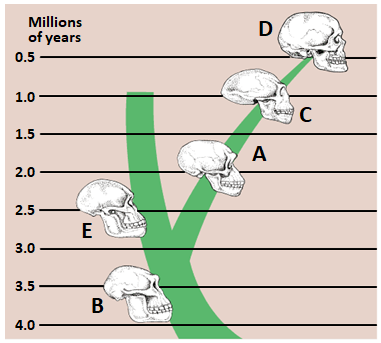Select Question Set:
A process in which heritable variations enabling better survival are enabled to reproduce and leave greater number of progeny is called:
1. Evolution
2. Saltation
3. Speciation
4. Natural selection
Subtopic: Hardy Weinberg Law |
78%
From NCERT
Please attempt this question first.
Hints
Please attempt this question first.
In 1953, S.L. Miller created conditions similar to those suggested by Oparin and Haldane in a laboratory where he created electric discharge in a closed flask containing:
| 1. | CH4, H2, NH3 and water vapour at 800°C |
| 2. | CH4, H2, HCN and hydrogen sulphide at 400°C |
| 3. | CO2, H2, NH3 and water vapour at 800°C |
| 4. | CO2, H2, HCN and hydrogen sulphide at 400°C |
Subtopic: Urey & Miller Experiment |
94%
From NCERT
Please attempt this question first.
Hints
Please attempt this question first.
Darwin’s finches represent one of the best examples of:
1. Saltation
2. Sympatric speciation
3. Adaptive radiation
4. Convergent evolution
1. Saltation
2. Sympatric speciation
3. Adaptive radiation
4. Convergent evolution
Subtopic: Additional Theories of Darwin | Concept of Organic Evolution: Evidence |
94%
From NCERT
Please attempt this question first.
Hints
Please attempt this question first.
Populations at genetic equilibrium [Hardy Weinberg equilibrium]:
1. are very small
2. are not experiencing any natural selection
3. have individuals frequently going out and coming in
4. are mating randomly
Subtopic: Hardy Weinberg Law |
62%
Please attempt this question first.
Hints
Adaptations for evolutionary significance:
| 1. | develop throughout the lifetime of organisms and are then passed on to their offspring |
| 2. | develop after a population encounters a change in environment |
| 3. | are inherited characteristics |
| 4. | decrease the chances of the organism surviving until maturity |
Subtopic: Concept of Organic Evolution: Evidence |
Please attempt this question first.
Hints
Working independently, who reached conclusions similar to those reached by Darwin on evolution of life forms?
1. T R Malthus
2. Hugo de Vries
3. Alfred Russell Wallace
4. Jean Baptist Lamarck
1. T R Malthus
2. Hugo de Vries
3. Alfred Russell Wallace
4. Jean Baptist Lamarck
Subtopic: Theory of Evolution & Lamarckism | Darwin's Theory |
71%
From NCERT
Please attempt this question first.
Hints
Please attempt this question first.
The diagram shows a possible family tree for humans. If D is Homo sapiens, what can be A and C respectively?

1. Ramapithecus and Sivapithecus
2. Sivapithecus and Ramapithecus
3. Homo habilis and Homo erectus
4. Homo erectus and Homo habilis

1. Ramapithecus and Sivapithecus
2. Sivapithecus and Ramapithecus
3. Homo habilis and Homo erectus
4. Homo erectus and Homo habilis
Subtopic: Introduction to Human Evolution | Evolution of Homo Sapiens |
82%
From NCERT
Please attempt this question first.
Hints
Please attempt this question first.
Oparin and Haldane proposed that:
1. Only I is correct
2. Only II is correct
3. Both I and II are correct
4. Both I and II are incorrect
| I: | First form of life could have come from pre-existing non-living organic molecules. |
| II: | Formation of life was preceded by chemical evolution. |
2. Only II is correct
3. Both I and II are correct
4. Both I and II are incorrect
Subtopic: Examples of Chemical Evolution | Urey & Miller Experiment |
81%
From NCERT
Please attempt this question first.
Hints
Please attempt this question first.
Consider the given statements regarding evidences of evolution:
The correct statements are:
1. I, III and IV only
2. I, II and V only
3. I, II, III and IV only
4. II, III, IV and V only
| I. | Paleontological evidence deals with the fossils that are generally found in sedimentary rocks. |
| II. | Karl Ernst von Baer said that embryos pass through the adult stages of other animals. |
| III. | Homology is based on divergent evolution whereas analogy is based on convergent evolution. |
| IV. | The thorn and tendrils of Bougainvillea and Cucurbita represent homology and Sweet potato and potato represent analogy. |
| V. | In industrial melanism, the dark melanic form was repeatedly wiped out but arose again and again by a recurring mutation. |
The correct statements are:
1. I, III and IV only
2. I, II and V only
3. I, II, III and IV only
4. II, III, IV and V only
Subtopic: Palentological Evidences of Evolution | Concept of Organic Evolution: Evidence |
73%
From NCERT
Please attempt this question first.
Hints
Please attempt this question first.
Consider the given statements regarding Hardy-Weinberg equilibrium and the conditions affecting it:
The number of correct statements is:
1. 2
2. 3
3. 4
4. 5
| I | It states that, provided some pre-conditions are met with, allele frequencies in a population are stable and constant from generation to generation. |
| II | Change of frequency of alleles in a population is interpreted as resulting in evolution. |
| III | If the change in frequency of alleles in a population occurs by chance, it is called genetic drift. |
| IV | In a population at genetic equilibrium if the frequency of recessive allele is 0.3 then about 42% of the population will be heterozygous for the trait. |
| V | Natural selection can lead to disruption when more individuals acquire value other than the mean character value. |
The number of correct statements is:
1. 2
2. 3
3. 4
4. 5
Subtopic: Natural Selection | Hardy Weinberg Law |
52%
From NCERT
Please attempt this question first.
Hints
Please attempt this question first.






